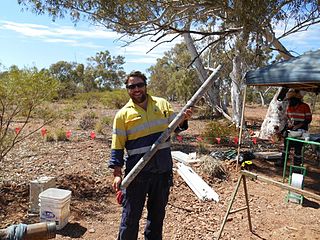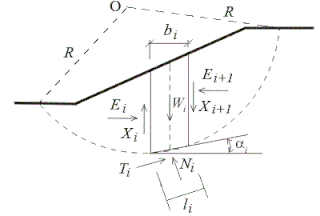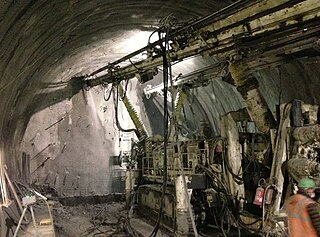Related Research Articles

Geotechnical engineering, also known as geotechnics, is the branch of civil engineering concerned with the engineering behavior of earth materials. It uses the principles of soil mechanics and rock mechanics to solve its engineering problems. It also relies on knowledge of geology, hydrology, geophysics, and other related sciences.

Engineering geology is the application of geology to engineering study for the purpose of assuring that the geological factors regarding the location, design, construction, operation and maintenance of engineering works are recognized and accounted for. Engineering geologists provide geological and geotechnical recommendations, analysis, and design associated with human development and various types of structures. The realm of the engineering geologist is essentially in the area of earth-structure interactions, or investigation of how the earth or earth processes impact human made structures and human activities.

Soil mechanics is a branch of soil physics and applied mechanics that describes the behavior of soils. It differs from fluid mechanics and solid mechanics in the sense that soils consist of a heterogeneous mixture of fluids and particles but soil may also contain organic solids and other matter. Along with rock mechanics, soil mechanics provides the theoretical basis for analysis in geotechnical engineering, a subdiscipline of civil engineering, and engineering geology, a subdiscipline of geology. Soil mechanics is used to analyze the deformations of and flow of fluids within natural and man-made structures that are supported on or made of soil, or structures that are buried in soils. Example applications are building and bridge foundations, retaining walls, dams, and buried pipeline systems. Principles of soil mechanics are also used in related disciplines such as geophysical engineering, coastal engineering, agricultural engineering, hydrology and soil physics.

Slope stability refers to the condition of inclined soil or rock slopes to withstand or undergo movement; the opposite condition is called slope instability or slope failure. The stability condition of slopes is a subject of study and research in soil mechanics, geotechnical engineering and engineering geology. Analyses are generally aimed at understanding the causes of an occurred slope failure, or the factors that can potentially trigger a slope movement, resulting in a landslide, as well as at preventing the initiation of such movement, slowing it down or arresting it through mitigation countermeasures.
Rock Structure Rating (RSR) is a quantitative method for describing quality of a rock mass and appropriate ground support, in particular, for steel-rib support, developed by Wickham, Tiedemann and Skinner.

Karl von Terzaghi was an Austrian mechanical engineer, geotechnical engineer, and geologist known as the "father of soil mechanics and geotechnical engineering".

Rock mechanics is a theoretical and applied science of the mechanical behavior of rocks and rock masses.
Slope mass rating (SMR) is a rock mass classification scheme developed by Manuel Romana to describe the strength of an individual rock outcrop or slope. The system is founded upon the more widely used RMR scheme, which is modified with quantitative guidelines to the rate the influence of adverse joint orientations.

Slope stability analysis is a static or dynamic, analytical or empirical method to evaluate the stability of slopes of soil- and rock-fill dams, embankments, excavated slopes, and natural slopes in soil and rock. It is performed to assess the safe design of a human-made or natural slopes and the equilibrium conditions. Slope stability is the resistance of inclined surface to failure by sliding or collapsing. The main objectives of slope stability analysis are finding endangered areas, investigation of potential failure mechanisms, determination of the slope sensitivity to different triggering mechanisms, designing of optimal slopes with regard to safety, reliability and economics, designing possible remedial measures, e.g. barriers and stabilization.
Core recovery parameters describe the quality of core recovered from a borehole.
The Hoek–Brown failure criterion is an empirical stress surface that is used in rock mechanics to predict the failure of rock. The original version of the Hoek–Brown criterion was developed by Evert Hoek and E. T. Brown in 1980 for the design of underground excavations. In 1988, the criterion was extended for applicability to slope stability and surface excavation problems. An update of the criterion was presented in 2002 that included improvements in the correlation between the model parameters and the geological strength index (GSI).
A discontinuity in geotechnical engineering is a plane or surface that marks a change in physical or chemical characteristics in a soil or rock mass. A discontinuity can be, for example, a bedding, schistosity, foliation, joint, cleavage, fracture, fissure, crack, or fault plane. A division is made between mechanical and integral discontinuities. Discontinuities may occur multiple times with broadly the same mechanical characteristics in a discontinuity set, or may be a single discontinuity. A discontinuity makes a soil or rock mass anisotropic.
Within geotechnical engineering, Laubscher developed the Mining Rock Mass Rating (MRMR) system by modifying the Rock Mass Rating (RMR) system of Z. T. Bieniawski. In the MRMR system the stability and support are determined with the following equations:
The rock mass rating (RMR) is a geomechanical classification system for rocks, developed by Z. T. Bieniawski between 1972 and 1973. Since then it has undergone multiple modifications out of which, RMR89 is commonly used. Recently RMR14 has been proposed to improve the RMR performance by incorporating new experiences from tunnel practices. Continuous functions and a software "QuickRMR" for RMR89 and RMR14 have also been proposed by Kundu. RMR combines the most significant geologic parameters of influence and represents them with one overall comprehensive index of rock mass quality, which is used for the design and construction of excavations in rock, such as tunnels, mines, slopes, and foundations.
The Q-system for rock mass classification is developed by Barton, Lien, and Lunde. It expresses the quality of the rock mass in the so-called Q-value, on which design are based and support recommendations for underground excavations.
The shear strength of a discontinuity in a soil or rock mass may have a strong impact on the mechanical behavior of a soil or rock mass. The shear strength of a discontinuity is often considerably lower than the shear strength of the blocks of intact material in between the discontinuities, and therefore influences, for example, tunnel, foundation, or slope engineering, but also the stability of natural slopes. Many slopes, natural and man-made, fail due to a low shear strength of discontinuities in the soil or rock mass in the slope. The deformation characteristics of a soil or rock mass are also influenced by the shear strength of the discontinuities. For example, the modulus of deformation is reduced, and the deformation becomes plastic rather than elastic. This may cause, for example, larger settlement of foundations, which is also permanent even if the load is only temporary. Furthermore, the shear strength of discontinuities influences the stress distribution in a soil or rock mass.

Persistence determines the possibilities of relative movement along a discontinuity in a soil or rock mass in geotechnical engineering. Discontinuities are usually differentiated in persistent, non-persistent, and abutting discontinuities (figure).
The sliding criterion (discontinuity) is a tool to estimate easily the shear strength properties of a discontinuity in a rock mass based on visual and tactile characterization of the discontinuity. The shear strength of a discontinuity is important in, for example, tunnel, foundation, or slope engineering, but also stability of natural slopes is often governed by the shear strength along discontinuities.

The Q-slope method for rock slope engineering and rock mass classification is developed by Barton and Bar. It expresses the quality of the rock mass for slope stability using the Q-slope value, from which long-term stable, reinforcement-free slope angles can be derived.

The Analysis of Controlled Deformation in Rocks and Soils, translated from Italian Analisi delle Deformazioni Controllate nelle Rocce e nei Suoli (ADECO-RS), also known as The New Italian Tunneling Method (NITM), is a modern tunnel design and construction approach. ADECO-RS was proposed by Pietro Lunardi in the 1980s on the basis of long in-depth research into the stress-strain behavior of more than 1,000 km of tunnel and more than 9,000 faces. In the past few decades, ADECO-RS has been widely used in Italian railway, highway and large underground construction projects and has been incorporated into Italian tunnel design and construction specifications.
References
- ↑ Romana, Manuel R. (1993). "A Geomechanical Classification for Slopes: Slope Mass Rating". Rock Testing and Site Characterization. pp. 575–600. doi:10.1016/B978-0-08-042066-0.50029-X. ISBN 978-0-08-042066-0.
- ↑ Tomás, R.; Delgado, J.; Serón, J.B. (October 2007). "Modification of slope mass rating (SMR) by continuous functions". International Journal of Rock Mechanics and Mining Sciences. 44 (7): 1062–1069. doi:10.1016/j.ijrmms.2007.02.004.
- ↑ Tomás, R.; Cuenca, A.; Cano, M.; García-Barba, J. (January 2012). "A graphical approach for slope mass rating (SMR)". Engineering Geology. 124: 67–76. doi:10.1016/j.enggeo.2011.10.004.
- ↑ Pantelidis, Lysandros (25 September 2009). "An alternative rock mass classification system for rock slopes". Bulletin of Engineering Geology and the Environment. 69 (1): 29–39. doi:10.1007/s10064-009-0241-y. S2CID 128937472.
- ↑ Hack, R.; Price, D.; Rengers, N. (1 May 2003). "A new approach to rock slope stability – a probability classification (SSPC)". Bulletin of Engineering Geology and the Environment. 62 (2): 167–184. doi:10.1007/s10064-002-0155-4. S2CID 140693335.